What Is Digital Content?
Digital content is any information that is created, stored, and distributed in a digital format. Digital content can include text, images, audio, video, animations, interactive features, and more. This type of content can be used for various purposes, such as entertainment, education, communication, marketing, and e-commerce .
Some examples of digital content include:
- E-books, blogs, articles, and newsletters
- Podcasts, music, and audiobooks
- Videos, movies, TV shows, and live streams
- Games, apps, and software
- Social media posts, comments, and messages
- Websites, landing pages, and ads
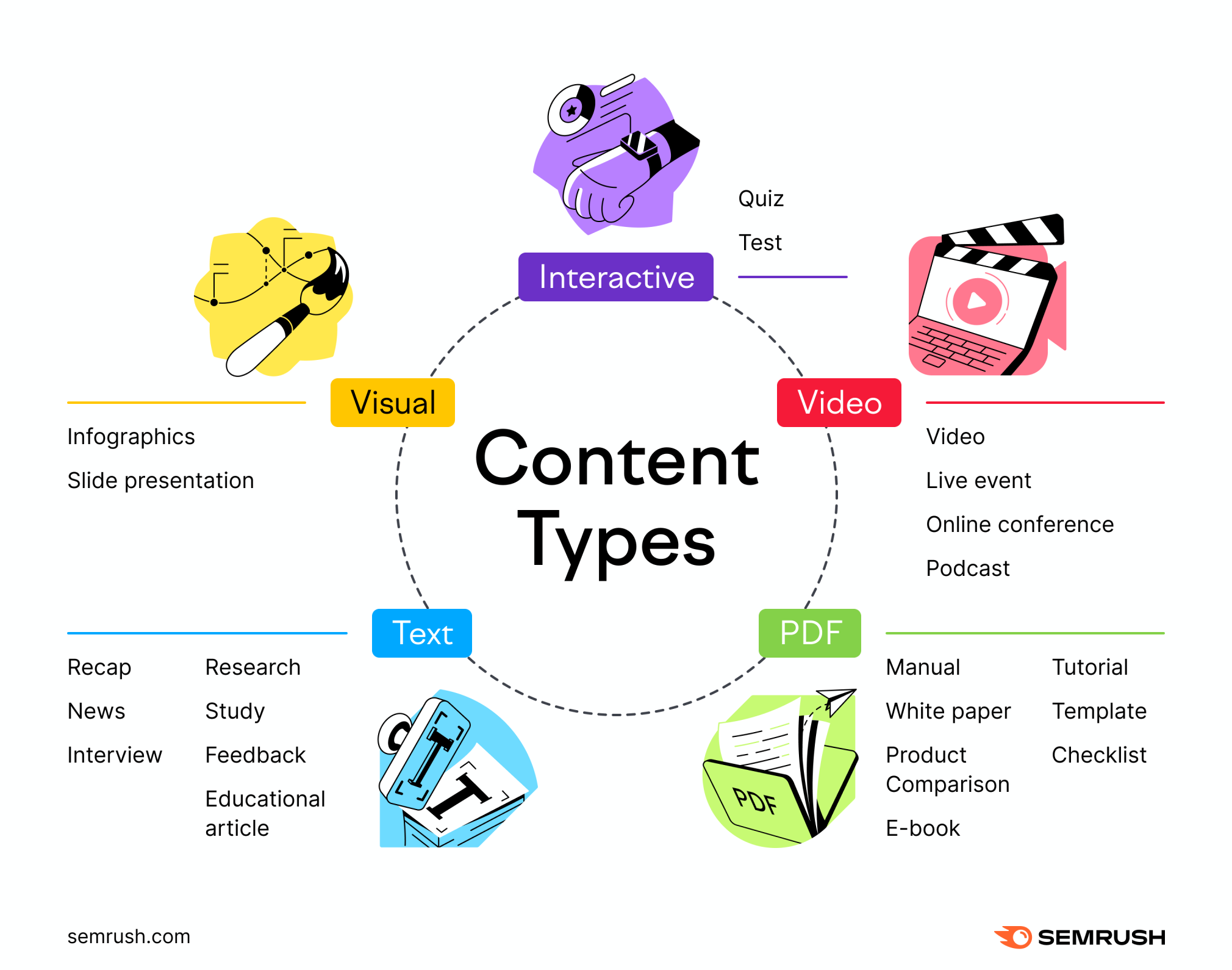
Why Is Digital Content Creation Important?
Creating quality content should be a key part of your digital marketing strategy because it helps you build trust, authority, and overall visibility.
And when you consistently create helpful content, your audience will likely begin to trust you as an authority in your niche.
Once your audience trusts you as an expert, it’s much easier to convince them to buy your product or service. You may not have to rely on sales tactics at all if your content is helpful enough.
This is a powerful way to build relationships with potential customers before they even decide to buy. You’ll be top-of-mind for when they’re ready to convert.
Let’s say your company sells fitness training programs. Like this bodybuilding expert, Jeff Nippard:
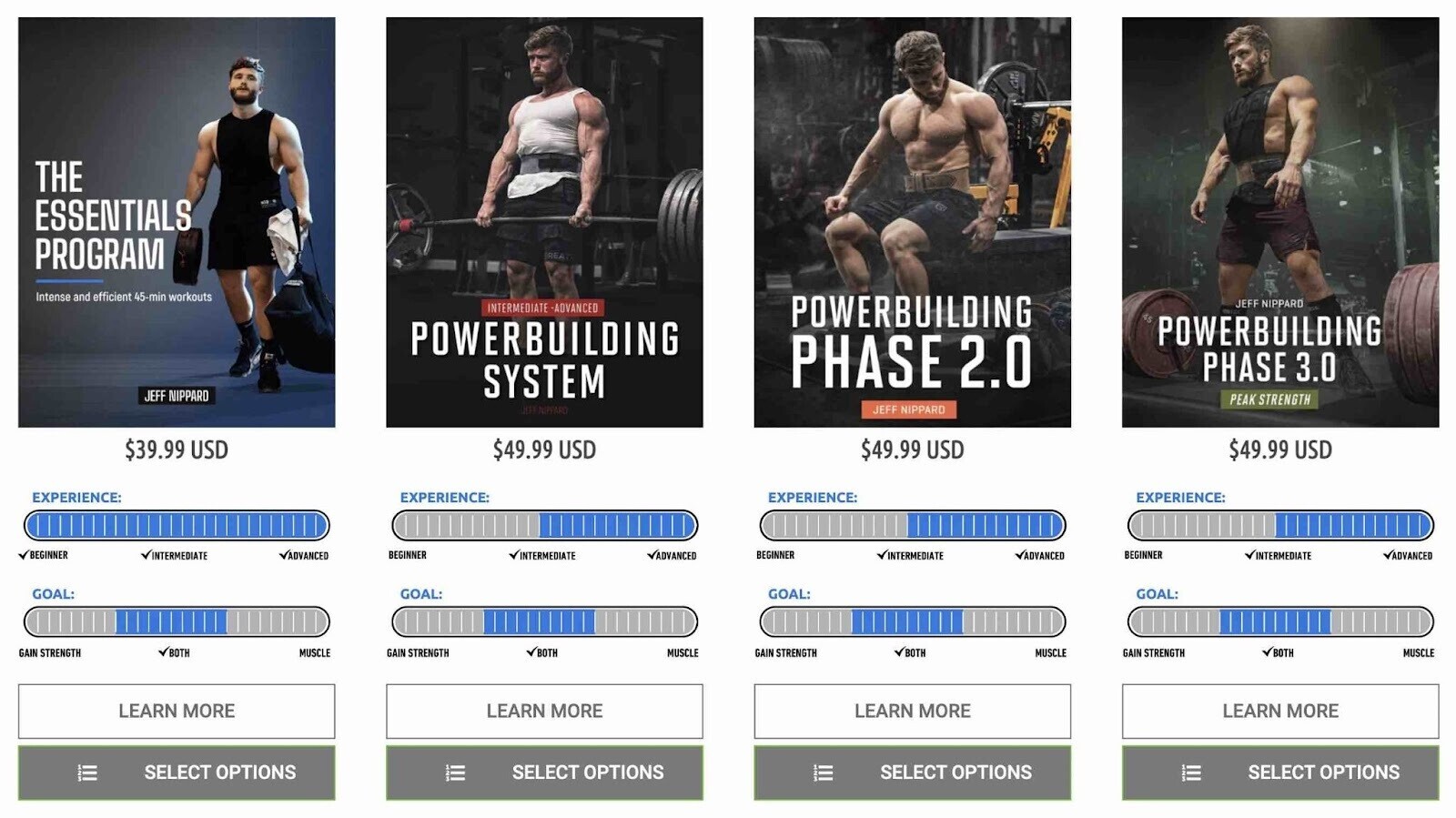
You could create content that positions you as an expert, like:
- A blog post about how much protein you need to eat in a day to gain muscle
- A YouTube video that explains what different exercise supplements do
- A case study on the effect of protein on fat loss
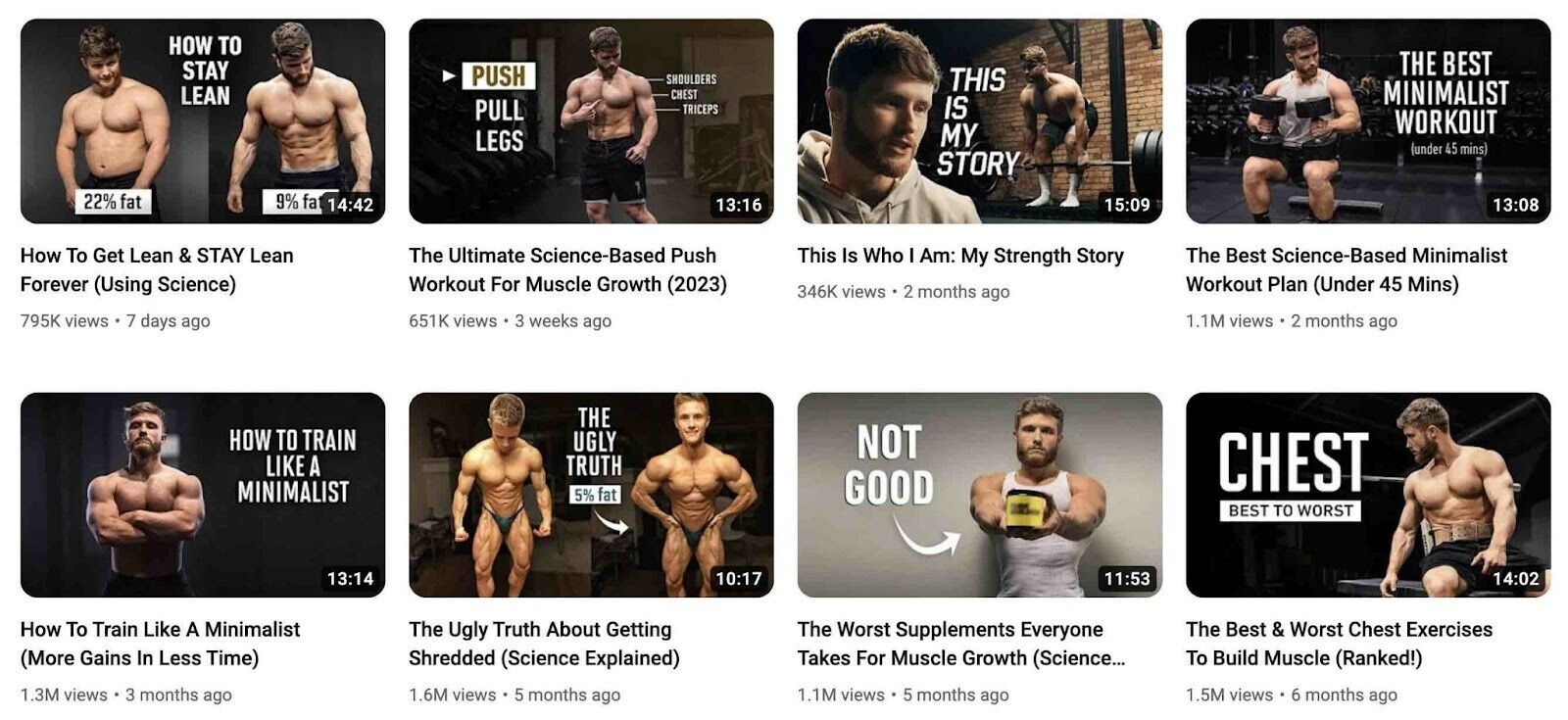
All of these topics build authority in your niche—which builds trust with your audience.
And audiences are more likely to engage with content they find valuable or interesting. Which will increase your content’s visibility.
So even more people can learn about your brand.
Now let’s cover how to create digital content.
The Digital Content Creation Process
The digital content production process has three stages:
- Research and planning
- Content creation
- Measuring performance
1. Research and Planning
The first step of content creation is generating ideas.
Start by performing audience research: who is your target audience? What do they want to know? And most importantly, how can your content help them?
You can use a tool like Semrush’s Market Explorer to do your research.
Start by entering your domain, adding a competitor’s domain, or analyzing your business category.
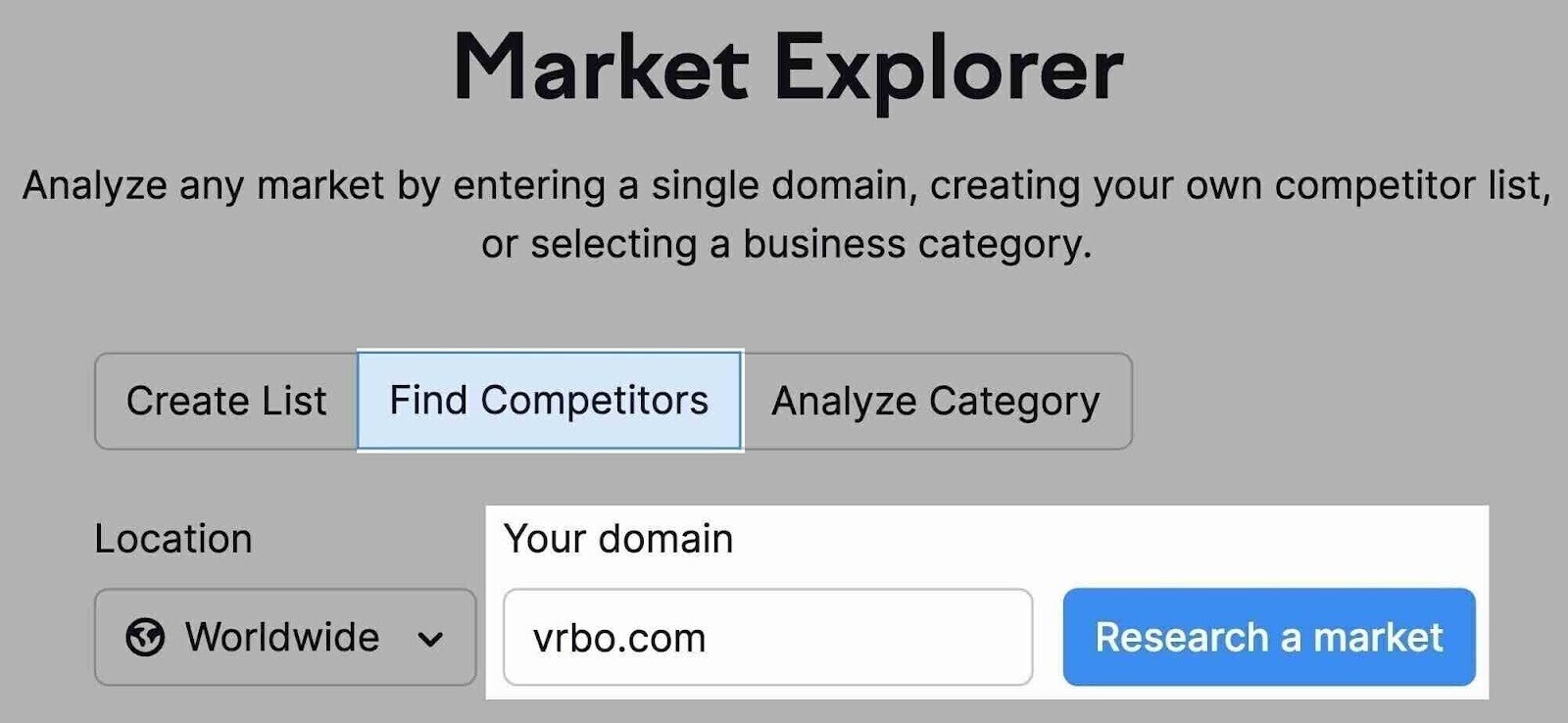
Then, head to the “Audience” report to see details about your target audience’s demographics.
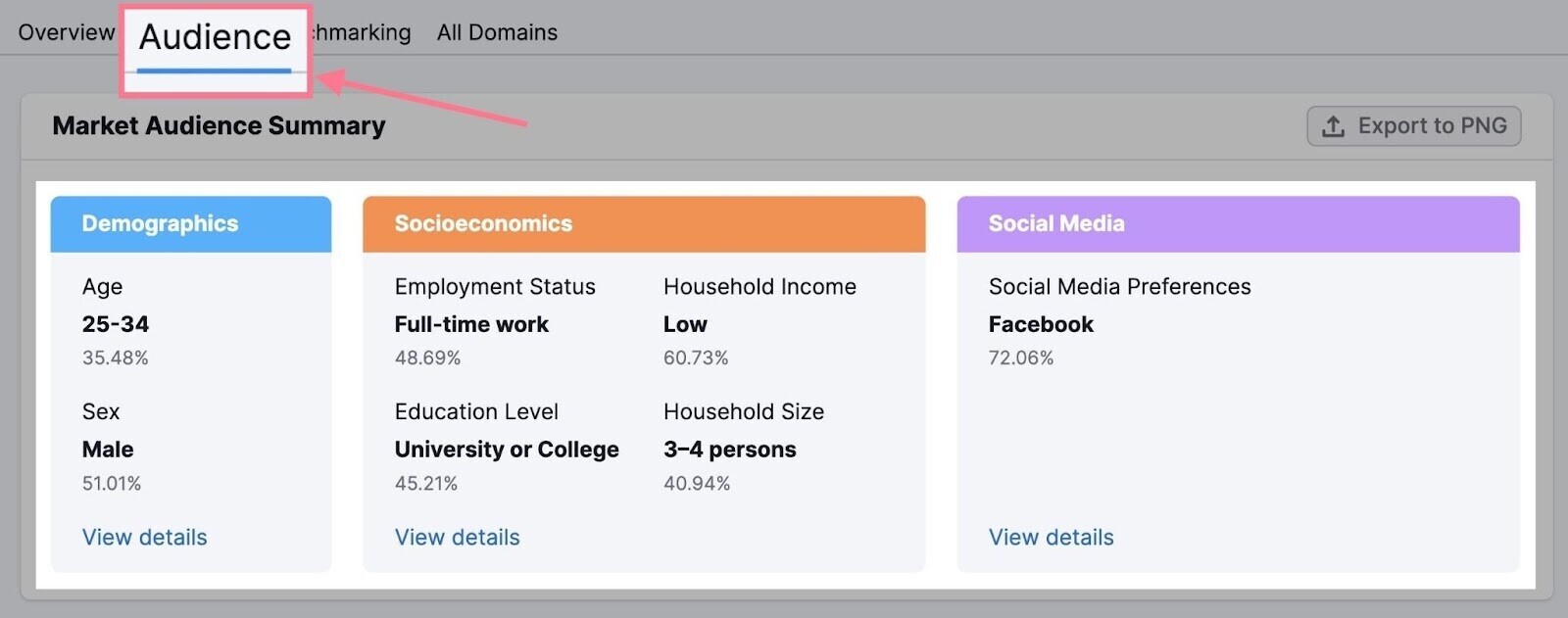
Pro tip: Consider your audience for each piece of content you produce. Does your content answer a question they have? Solve a problem? Provide entertainment?
If you’re starting entirely from scratch (or simply want to brainstorm), generate topic ideas with a tool like Topic Research.
Enter a topic, and the tool will provide you with sample headlines, questions, and related searches:
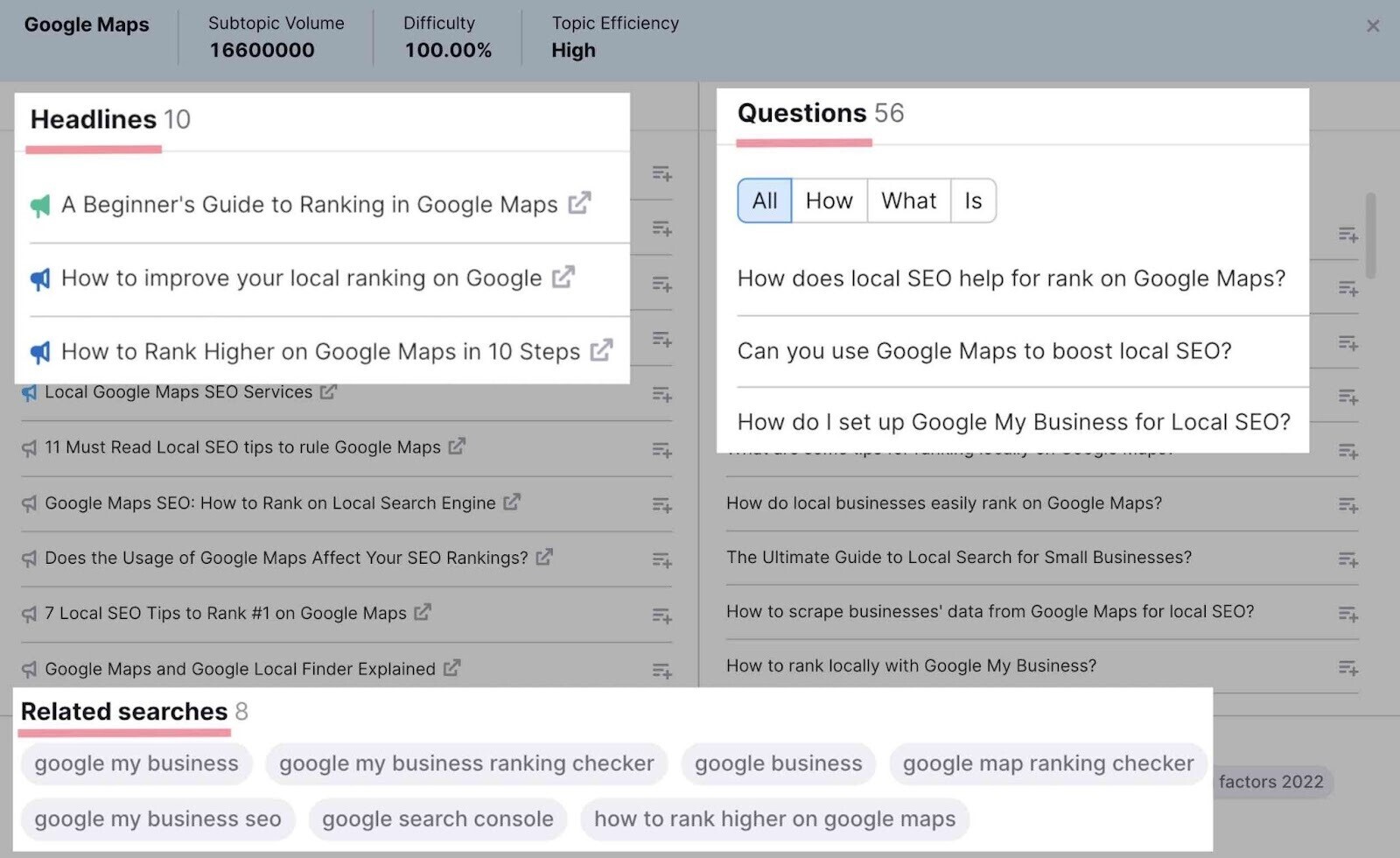
Topic Research is a good starting point because you can generate broad content ideas and related subtopics to cover.
Armed with audience information and some topics in mind, begin your keyword research.
You can use a tool like Semrush’s Keyword Magic Tool.
Start with a broad search term, like cat toys, and click “Search.”
The tool provides a comprehensive list of keyword ideas related to your search term:
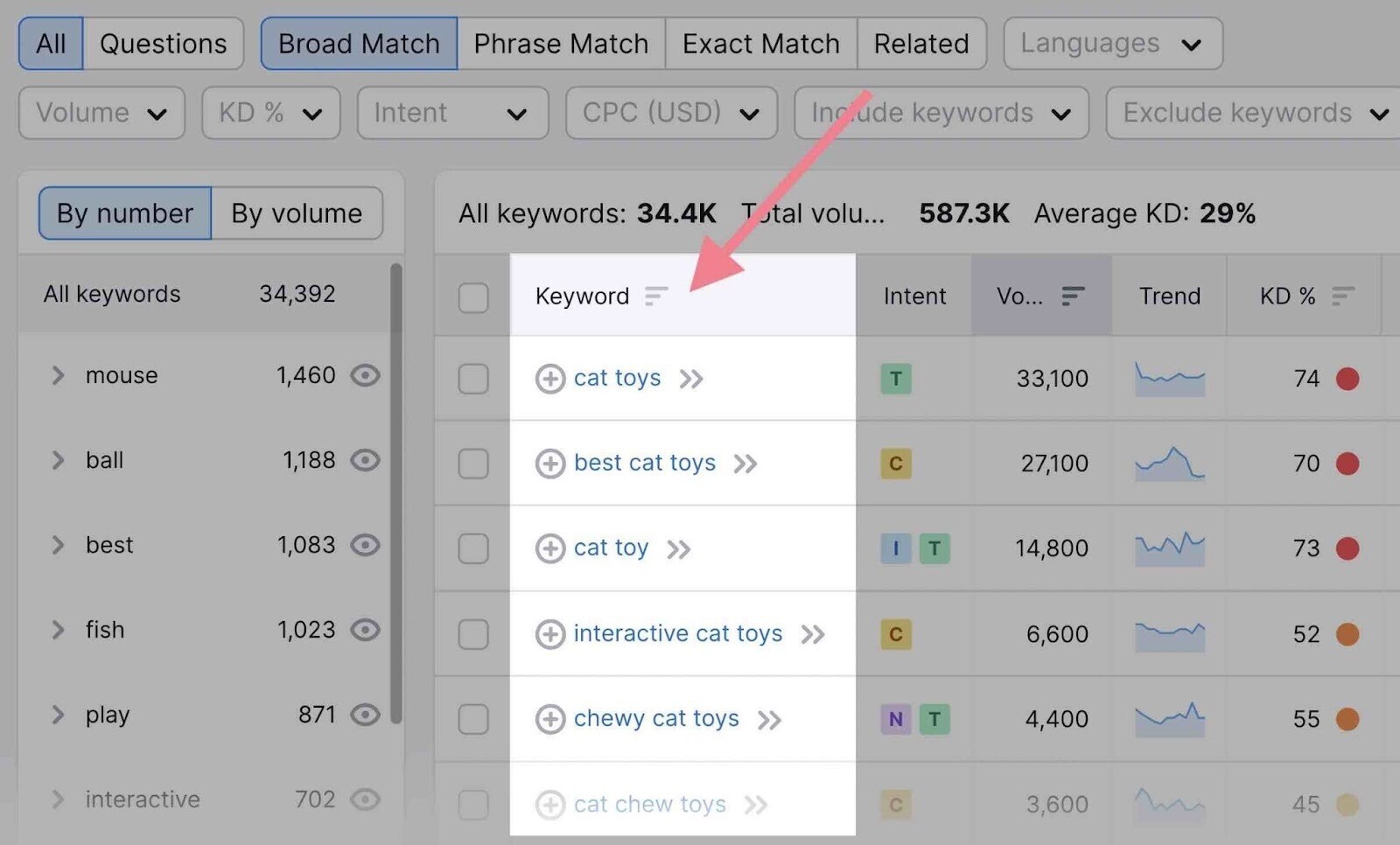
For more targeted results, click on a subtopic from the left-hand sidebar:
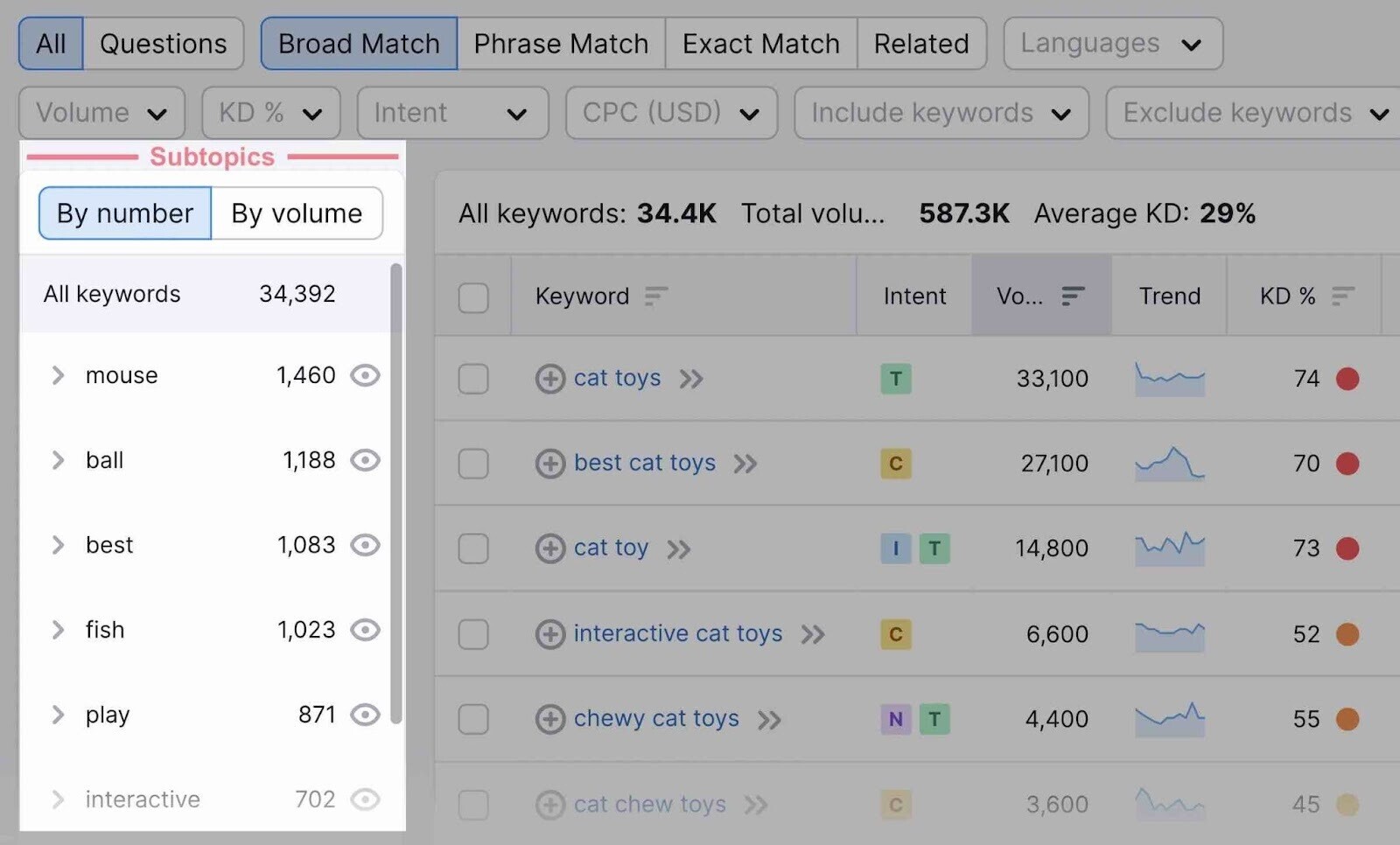
Or, filter your results by “Questions.” This can help you come up with more specific content topics.
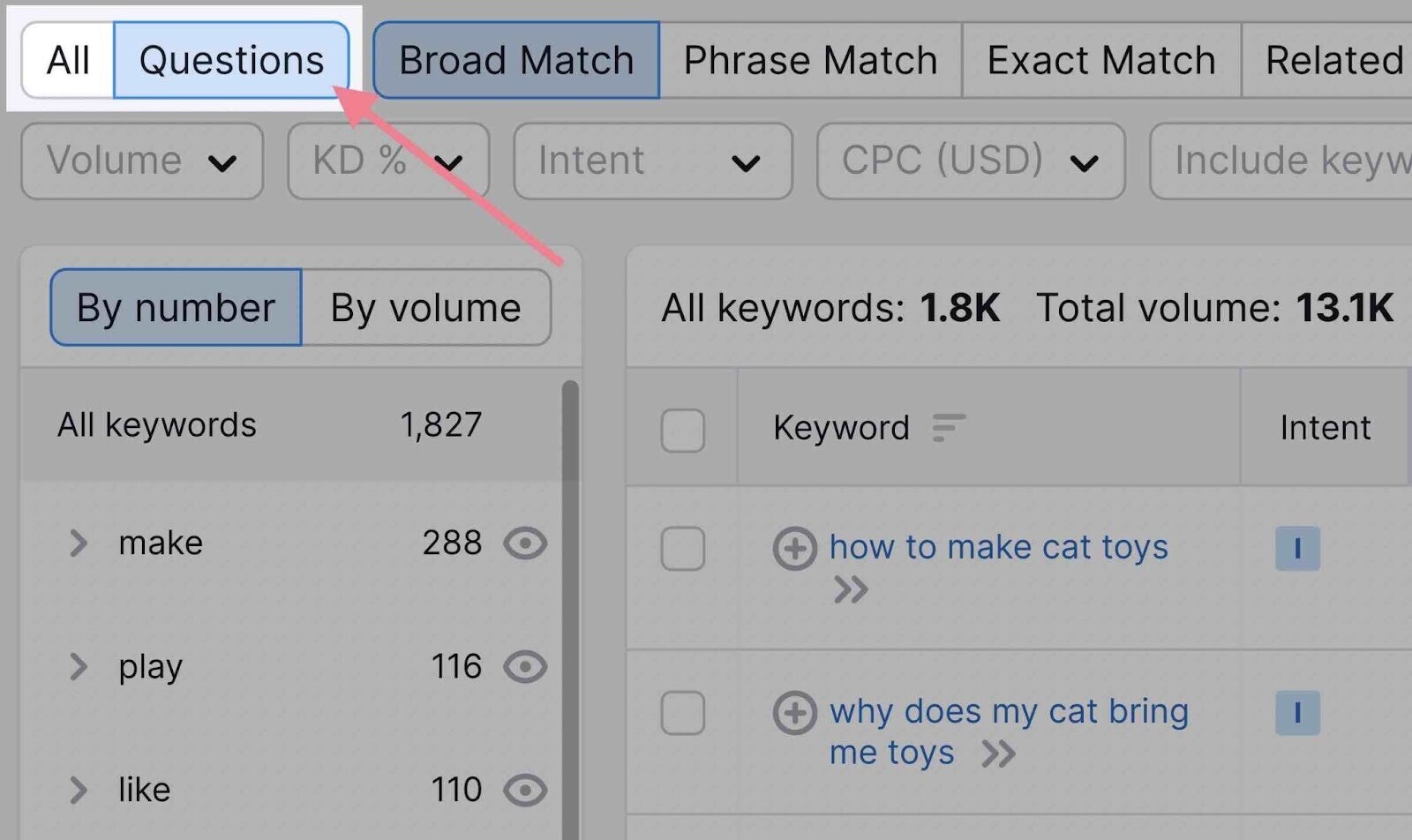
You’ll find plenty of long-tail keywords in the “Questions” category. Long-tail keywords are terms that typically have a lower search volume, but also lower competition.
Which means it will probably be easier to rank for these keywords over highly competitive terms.
You can see the search volume and competition level of any keyword while using Keyword Magic Tool:
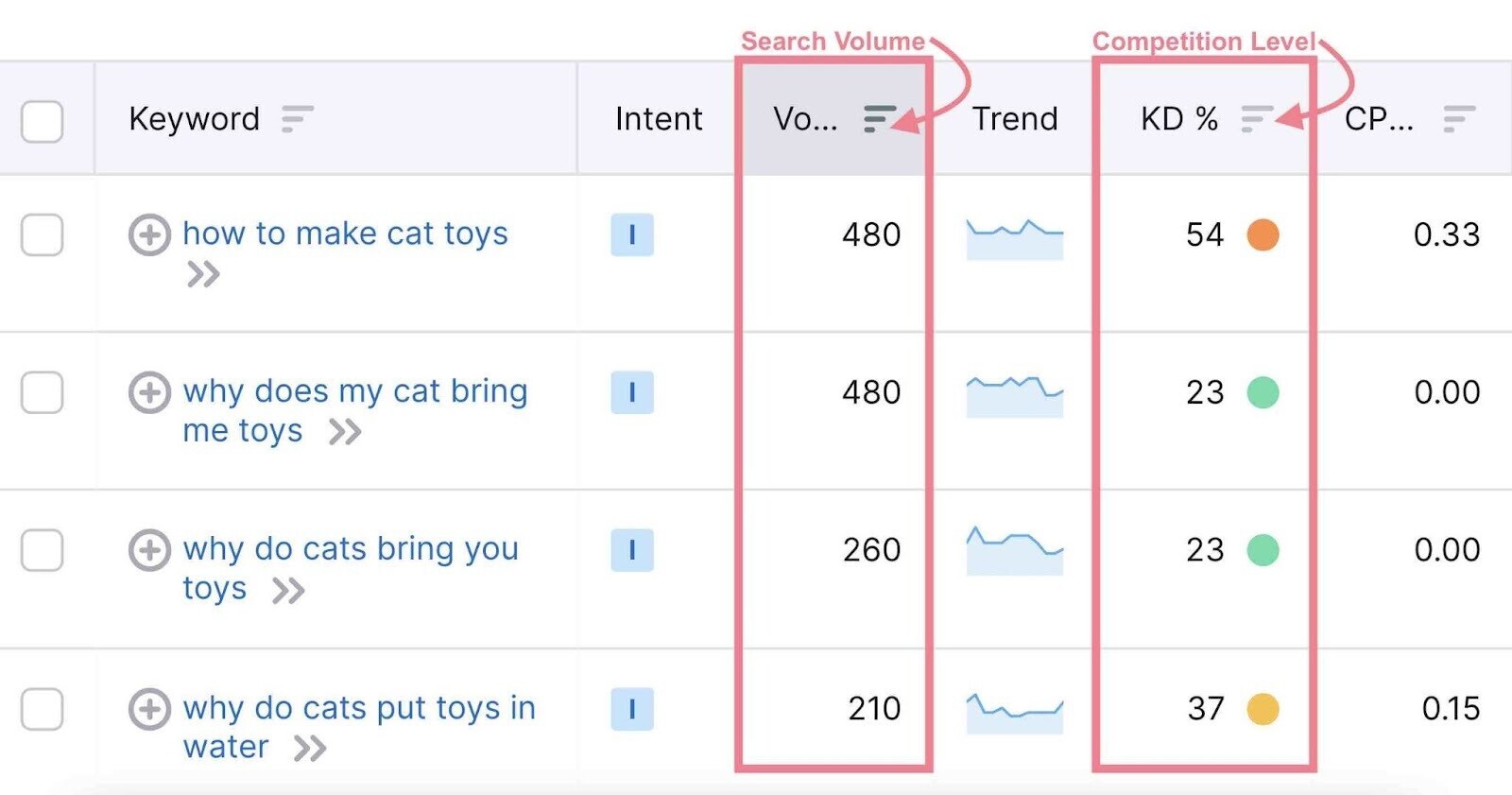
When you see keywords you like, add them to the Keyword Strategy Builder. You can organize keywords into different lists and export them to an XLSX file, CSV file, or other Semrush tool.
2. Content Creation
Once you’ve come up with clear topics, select a content format for each.
Do this by identifying the goal of your content. Do you want to raise brand awareness? A blog post or how-to video could work.
Maybe you want to generate leads. In this case, an ebook or research study could work well.
Side note: The content marketing funnel can help you decide what content to create.
Now that you have specific content ideas, create a formal content plan.
A content plan helps you map out exactly what you need for content creation and how you’re going to get it done.
Now it’s time to create your content.
Your content plan should include a brief for each topic. A brief is like a blueprint for each piece of content. It should detail why you’re creating something, what problem it addresses, and who is responsible for it.
A brief for a blog post typically includes:
- A short description of the goal of the content piece
- The assigned internal writer or external agency
- Primary and secondary target keywords
- Title suggestions that incorporate the primary target keyword
- An outline of potential subtopics
- Possible internal linking opportunities
Multimedia content briefs will be slightly different. For example, podcasts require a clear direction for:
- Episode frequency
- Guest outreach information
- Topics and talking points
- Hosting platforms
- Equipment
- Editing details
Regardless of the format, ensure that the content’s goal is clear. And remember to include any relevant information—like your content brief—in your content calendar.
3. Measuring Performance
The content creation process doesn’t end once you click “publish.” Now it’s time to track your results to see if you got the results you wanted.
And if you don’t see results, find out what went wrong. And note how you can fix it.
Measure the performance of your site’s content in Google Analytics.
Depending on your content goal, you may measure your performance against a number of metrics.
Let’s say you want to see how your content is converting prospects into leads.
In Google Analytics, head to “Conversions,” “Goals,” then “Overview” to find your “Goal Conversion Rate”:
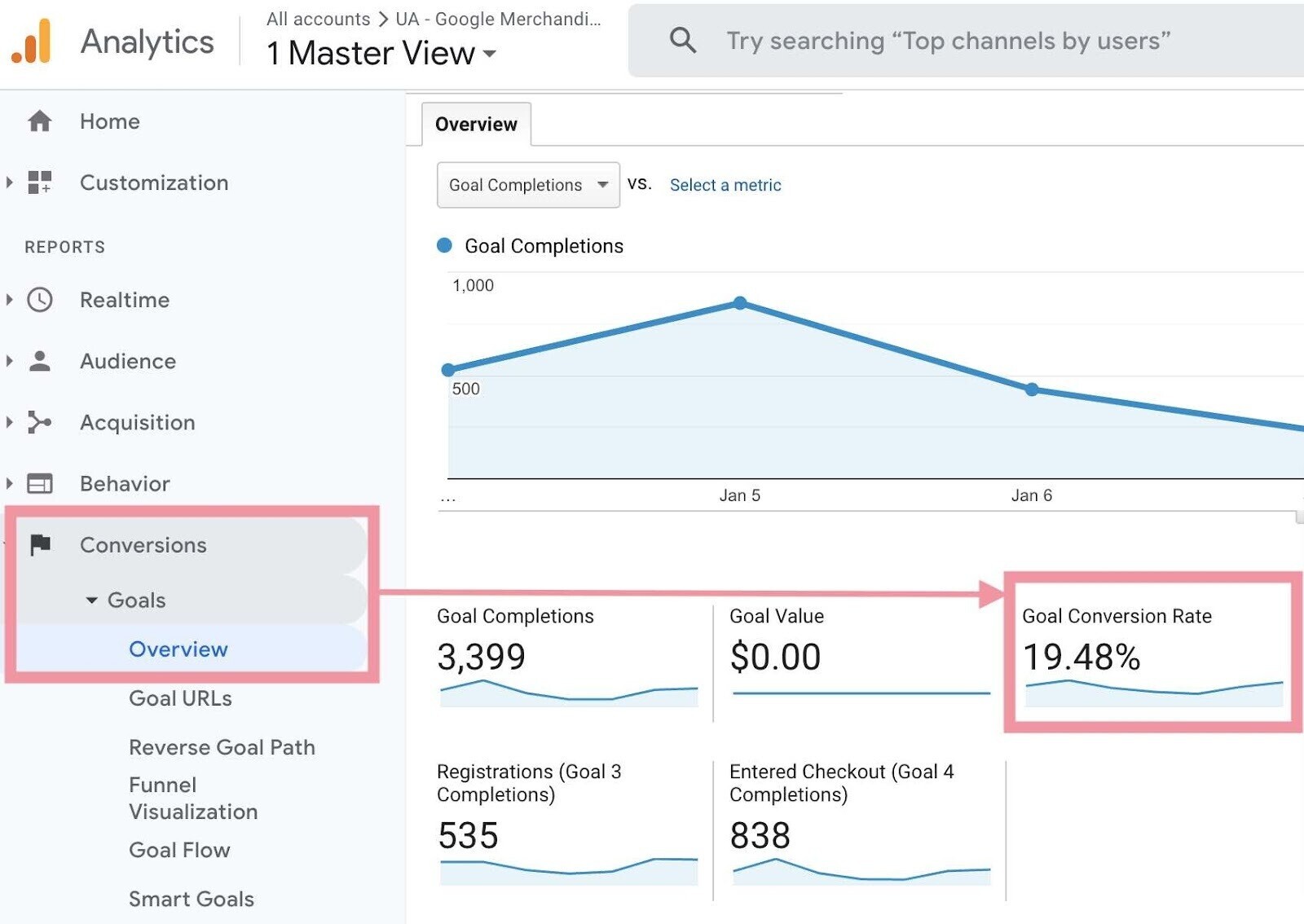
In GA4, you can see your “Session conversion rate” by channel in your Traffic Acquisition report, too:
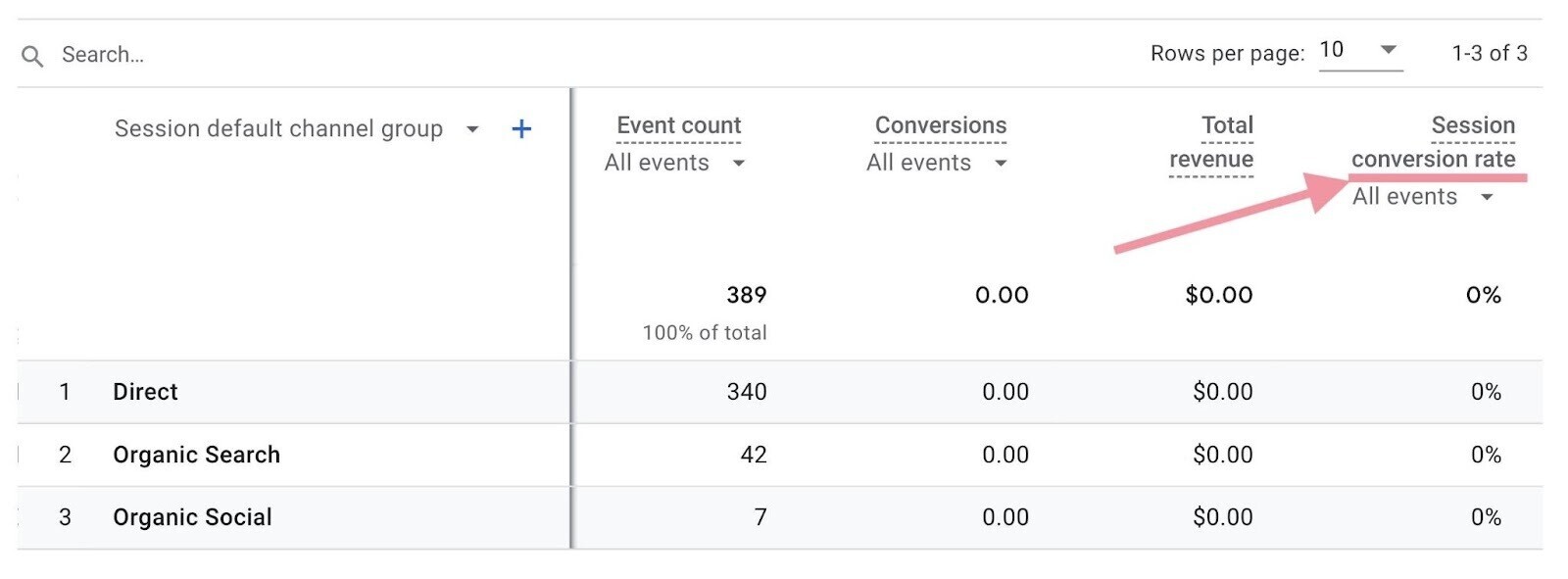
Note: If you haven’t used Google Analytics before, read our guide to getting started. Or check out our guide to metrics worth tracking in both GA and GA4.
And if you want to see how your site’s content measures up to your competitors’, use Semrush.
You can connect your Google Analytics and Google Search Console accounts to view your own data alongside our estimated competitor data.
But the process isn’t over once you check your results. Continue refining individual content pieces—along with your overall content strategy—based on metrics.
For more information on checking content performance, read our beginner’s guide to Google Analytics.
Digital Content Creation Ideas
We’ve covered the steps of creating content—but you can’t start without an idea.
Here are some ideas to kickstart the process for a few popular content formats.
Blog Posts
Blogging is one of the most common forms of content creation. Blog posts educate, inform, or entertain readers through written content.
They build your brand and credibility. Plus, they can generate quite a bit of traffic.
Take this case study about a bakery that used blogging to grow its organic traffic by 214%.
But starting to blog can feel overwhelming at first—topics you could write about are endless.
We recommend beginning with keyword research to determine what topics your audience wants to learn about.
Targeting question-based keywords is a good place to start. Because these keywords provide a built-in topic to cover.
Take the keyword “how to build a birdhouse.”
There’s a clear purpose behind the keyword—the searcher wants to learn how to do something.
Create a blog post that details exactly how to accomplish the topic. In this case, how to build a birdhouse.
You can even brainstorm related questions directly in Google Search.
When you type a question into Google, you’ll sometimes see a “People Also Ask” box. This shows questions other users have searched for.
So if we scroll through the results of “how to build a birdhouse,” we see related questions we could write about. Or use as subtopics for our initial blog post idea:

Here are some additional ways to generate some blog post topics to get you started:
- Share opinions and knowledge with a thought leadership blog post
- Compare your product or service to other popular options in your niche
- Create an entertaining listicle readers can share on social media
- Highlight original research
- Analyze industry news and trends
Gated Content
Gated content is only accessible to users when they fill out a form and provide their email. Many businesses use this as a lead-generating strategy.
The user gets useful content—and the business gets a lead.
Common forms of gated content include the following:
- White papers
- Ebooks
- Templates
- Webinars
- Research reports
If you aren’t sure where to start, look at your most popular blog posts. What topics are your users interested in?
Or look at your industry in general. What are people talking about in your niche?
Pro tip: Use an app like TrendFeed to find newsworthy topics.
For example, Semrush’s State Of Content Marketing report showcases content marketing trends for each year. Plus, the perspectives of industry leaders.
You can also generate ideas by asking your sales team about customers’ common questions and feedback.
Say your customers have many questions about one particular tool or service you offer. This could be a great opportunity to host a live webinar demonstration.
Read our guide to gated content to learn more about the different formats.
Graphics
Incorporating visual content is a great way to supplement your written content. Visuals can set your content apart. And blog posts with at least one image get twice as much traffic as text-only posts.
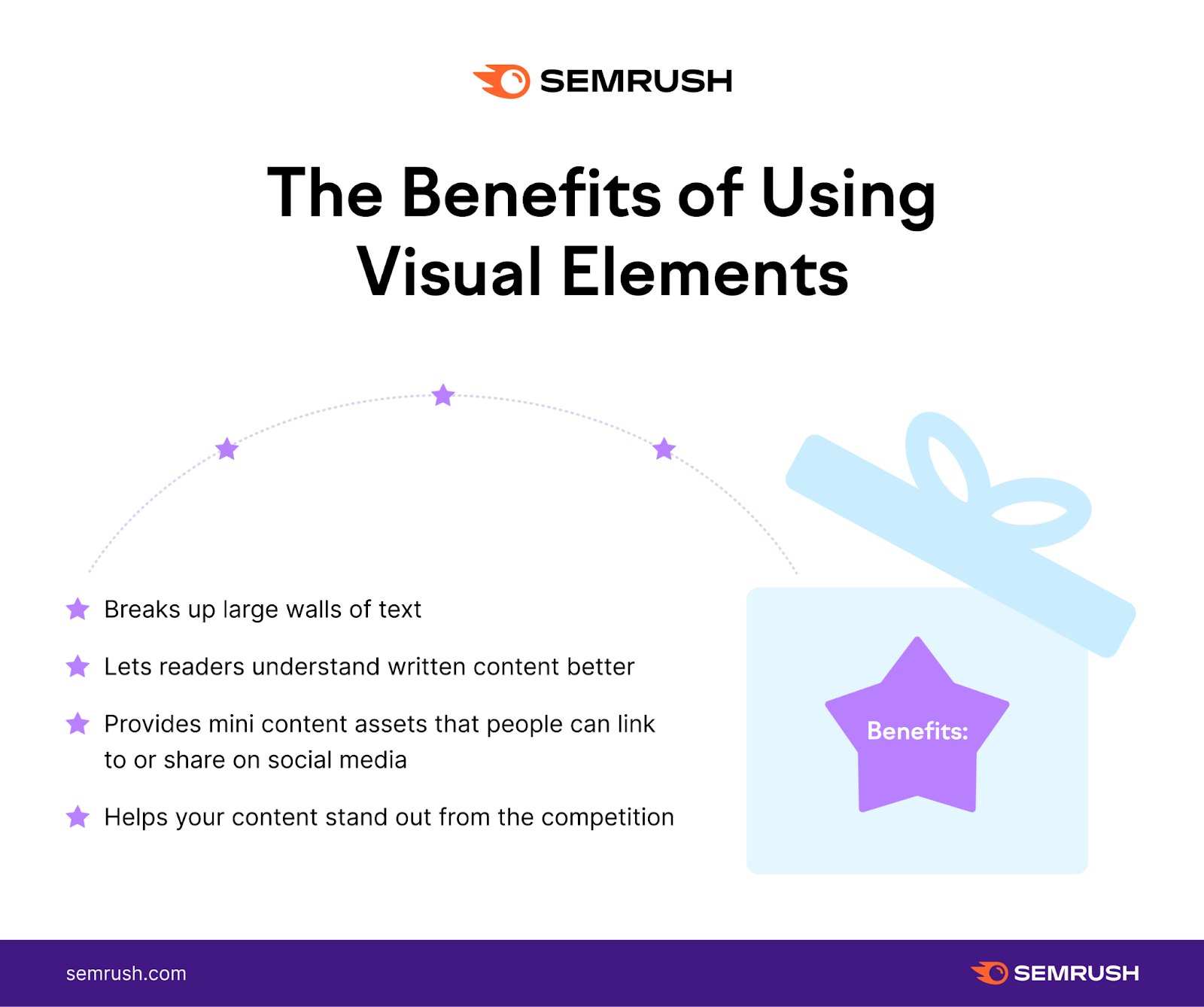
We recommend repurposing visual content across various platforms.
For example, add an infographic to a blog post to break down complex information. Then share the visual on social media to attract traffic and links.
Even if you don’t have a dedicated design team, you can use free tools like Canva, ImageOptim, GIMP image editor, and Pexels for stock photos.
You can also leverage user-generated content. This refers to any content created by users—not brands.
This gets your followers involved with your brand.
User-generated content comes in many forms—photos, videos, reviews—but you can start simply by creating a custom hashtag on social media.
Encourage your followers to post photos using your product. Then share their photos for mutual exposure.
Note: Be sure to get permission before you share user-generated content. And always credit the creator.
Videos
Video content continues to become more and more popular. (TikTok’s downloads continue to grow.) So it’s wise to invest in both short-form and long-form video content.
YouTube is a good place to begin. While you can spend more time and resources on YouTube content later, you can start for free.
Most businesses have YouTube channels featuring educational content related to their products and industry.
Like Semrush, for example. We share content about topics related to SEO and marketing, like:
- SEO predictions for the coming year
- How to land your dream marketing job
- Understanding TikTok SEO

Or if you’d prefer to focus on short-form content, opt for TikTok or Instagram. (YouTube also has a subsection for short-term videos called YouTube Shorts.)
You can repurpose longer YouTube videos into shorter videos. Or get creative and create your own take on current social media trends (like fan-favorite TikTok account DuoLingo).
Not sure where to start? Here are a few ways to generate video content ideas:
- Repurpose blog posts
- Create how-to videos or tutorials
- Share product demos
- Create educational content about your industry
Podcasts
Podcasts are typically audio recordings of a conversation between two or more people about a specific topic.
These recordings are hosted on a podcast platform such as Apple Podcasts, Google Podcasts, or Spotify.
Podcasts build authority within your niche. The key here is to make the conversations relevant to the problems your target audience faces.
And podcasts are becoming increasingly popular—62% of US consumers listen to podcasts, with numbers growing year-over-year.
Here are a few podcast ideas to use as a springboard:
- Interview influencers within your niche
- Give your take on industry trends (another example of thought leadership)
- Compile listener stories and read them on-air
Learn More About Content Creation
Digital content creation forms the foundation of our online lives.
It’s how we get information, find inspiring ideas, connect with like-minded people, and reach a diverse audience.
Ready to create your own digital content? Here are a few resources to get you started:
